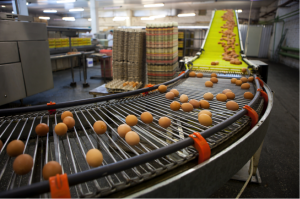A food handling program teaches that cross contamination occurs when harmful bacteria spreads to food from other food, surfaces, hands or equipment. Cross-contamination commonly occurs if equipment used for raw food preparation is then used for cooked or ready-to-eat food.
We’ll examine some preventative measures taken to eliminate cross contamination in the packaging industry, as well as what retailers in the UK are offering-up in their product lines to lower the risk of salmonella poisoning as well as other harmful risks associated with cross contamination.
Food Safety Regulations Prompt Manufacturers to Reconsider Equipment
Around the world, food manufacturers face mounting concerns about safety and contamination after increasing reports about hygiene failure. Food safety training students know that as consumer awareness about contamination increases, the pressure to promote hygienic manufacturing practices also increases.
One of the most failsafe ways to decrease contamination in food production is with better packaging and processing equipment design. There aren’t any global standards concerning equipment design just yet, but there are suggested guidelines for choosing equipment such as:
- Easy to clean: Experts advise against purchasing equipment that features hard to reach nooks and crannies or that may have an excess of mechanical dials and components. Simplified design reduces contamination risk.
- Minimize flat surfaces: Angled conveyors and surfaces ensure that any food residue flows downward and properly drains.
- Choose construction materials wisely: Manufacturer’s choice of cleaning product and procedures are often the best option. For example, stainless steel framed machinery for wet-washing.
UK Retailers Offer Chicken in a Bag
Recently, whole chickens in the UK are being sold with “roast in the bag” options. Consumers don’t have to touch the raw meat this way, so there’s no risk of exposure to harmful pathogens such as salmonella and campylobacter. Apparently, the bags are designed in such a way that allow for proper ventilation during cooking, without any leakage.
The chickens are actually doing quite well and account for over 30% of chicken sales. Companies are said to be releasing turkeys in a bag for the upcoming holiday season.
Raising awareness and preventative measures are always good, yet food handling courses will teach you that cross contamination prevention in the home is actually quite easy.
Hygienic Home Practice
Preventing cross contamination and reducing the risk of foodborne illness in the home is actually quite simple. The basic premise is to avoid contact of any food with raw meat or a surface or utensil that has been in direct contact with raw meat. Here’s a few helpful tips to keep in mind:
- When refrigerating food, make sure meats are packaged separately to prevent their juices from dripping onto anything.
- When preparing food always use a clean cutting board, and wash your hands immediately after cutting meats or handling raw eggs – the same principle applies to knives and other utensils.
- When cooking indoors or outdoors, never place cooked food back on the same plate or cutting board that previously held raw food.
Do you know of any other home solutions to cross contamination?




